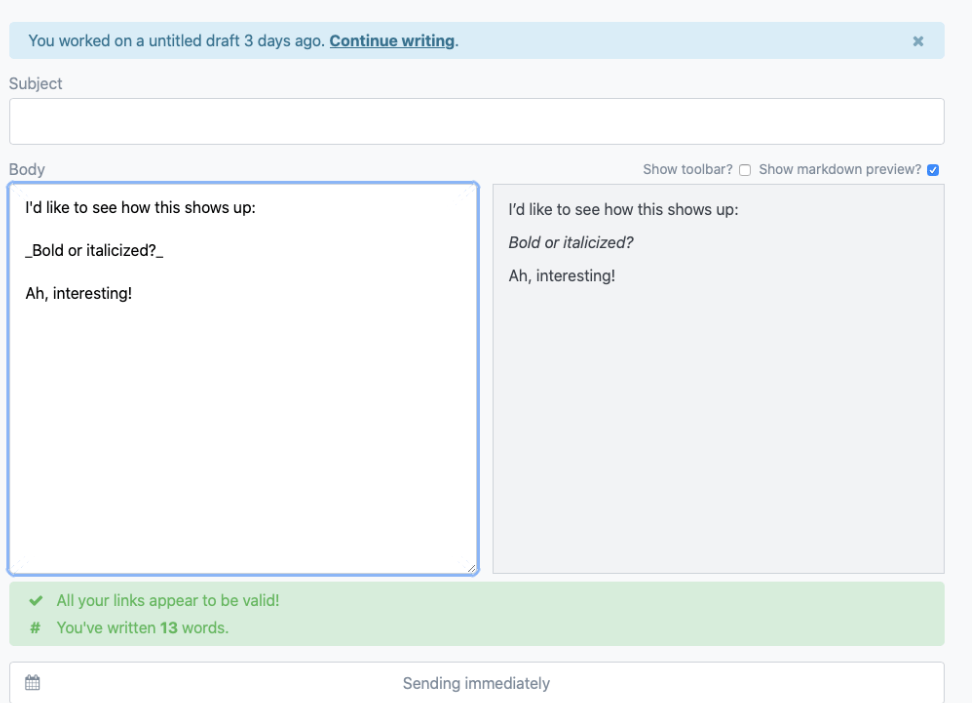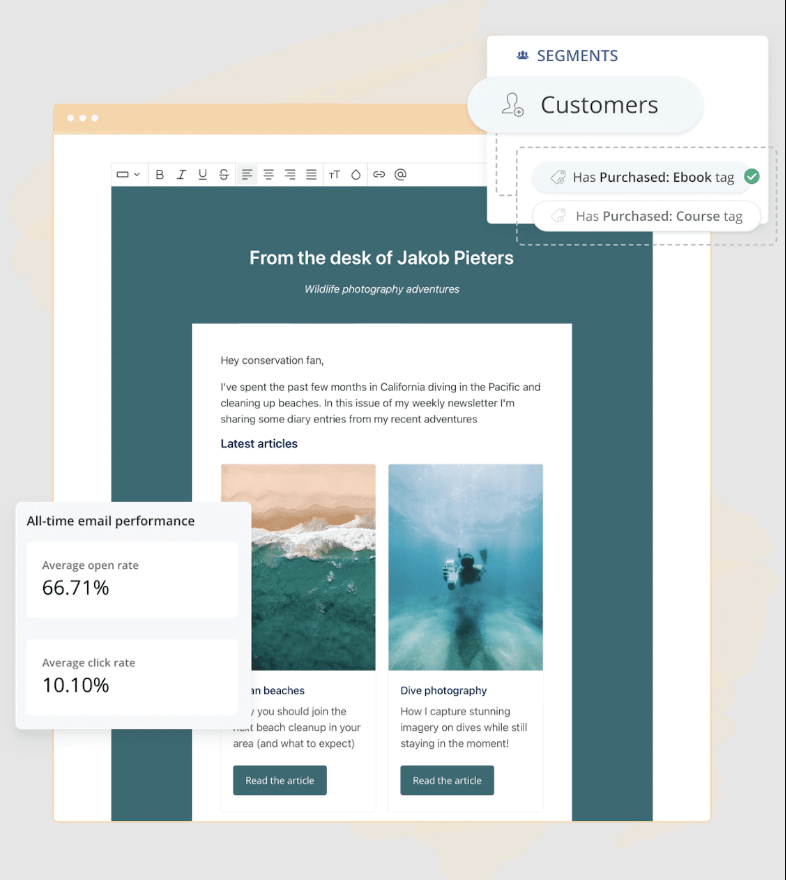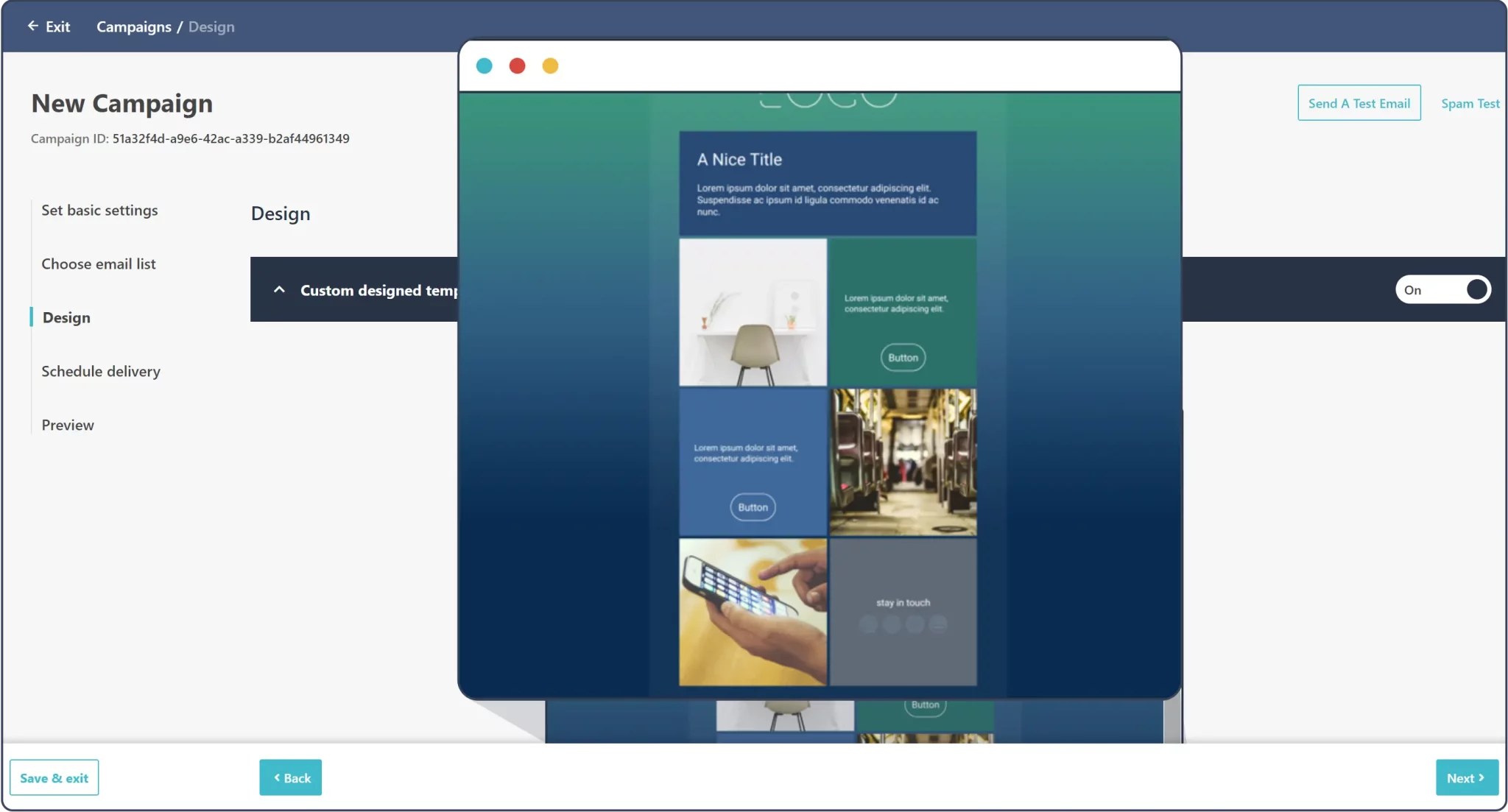When you want to send newsletters, you’ll need an Email Service Provider (ESP for short). With so many options and features available, it can quickly become overwhelming. That’s why we’ve done all the research for you! In this blog post, we compare 13 of the best newsletter platforms (or ESPs) on the market based on price, features, and customer reviews.
Here are the 3 questions you have to ask yourself before choosing an ESP:
- How quick is it to get started?
- Will the features help me?
- Is the pricing affordable and scalable for my audience size?
How much does it cost to send newsletters?
The number of subscribers you have is going to play a massive role in selecting the right ESP. As your newsletter’s audience grows, the cost of your ESP will increase.
If you have a small list—let’s say, 2,000 subscribers or less—there are plenty of incredible free and low-cost ESPs on the market.
If you have a much bigger list, like 20,000 subscribers or so, some ESPs offer advanced features for sustaining growth. However, the monthly costs tend to be much higher.
For example, check out this table to judge the approximate costs for smaller vs larger lists.
Monthly ESP Pricing for Small vs Large Audiences |
||
| Platform | Small List (2K) | Large List (20K) |
| Email Octopus | $0 | $50 |
| Substack | $0 | $0 |
| TinyLetter | $0 | n/a |
| Sendfox | $0* | $18* |
| MailerLite | $17 | $119 |
| Moosend | $24 | $160 |
| Buttondown | $29 | $139 |
| Campaign Monitor | $29 | $199 |
| Curated.co | $39 | $299 |
| Mailchimp | $40 | $220 |
| Beehiiv | $49 | $99 |
| ConvertKit | $49 | $179 |
| Ghost.org | $50 | $186 |
| *Requires a one-time membership fee | ||
Note: This isn’t a complete view of full ESP pricing packages, but it should give you an idea of how the charges scale upwards as your list grows.
Best Newsletter Platforms [13 ESPs Compared]
Beehiiv

Founded in 2021 by 3 former Morning Brew staffers, Beehiiv is an ESP built for newsletter growth and monetization. Every month, they continually roll out new features to help their customers send newsletters, stand out, and grow.
Beehiiv claims to strike the perfect balance between ease of use and powerful, no-code advanced features that power growth. These features include robust reporting, segmentation, and monetization tools. In fact, The Milk Road—a popular crypto newsletter—recently used Beehiiv to rapidly scale from 0 to 250,000 subscribers in less than a year.

Beehiiv pricing
- All essential newsletter functionality is free in beehiiv’s Launch plan for up to 2,500 subscribers.
- Premium memberships with extra features range from $49-$99 per month.
- No fees on earnings from paid subscribers.
Reviewers say:
- Beehiiv attracts a vocal following of reviewers who praise their product for its ease of use, user interface, and frequent feature updates:
Imagine being on Mailchimp when @Beehiiv exists
— litquidity (@litcapital) April 14, 2022
- Great free plan for hobbyists and new writers.
- More advanced features like programmatic ads can be pricey.
- Free plan offers 5x as many subscribers compared to Mailchimp. And beehiiv has unlimited sending on the free tier.
Buttondown

Buttondown is an easy-to-use newsletter platform that’s tailored for simple use cases and small businesses. It’s built by a developer (who’s also a newsletter writer) to solve many of the issues writers have with bigger ESPs. With Buttondown, you won’t get caught up in all the hustle and bustle of Mailchimp or Substack.
Buttondown also offers powerful tools like paid subscriptions, custom domains, and subscriber analytics. If you want a tool that’s fast, simple, free to start, and scalable, Buttondown is a great choice.

Buttondown pricing
Buttondown offers Free plans for <100 subscribers. Paid plans range from $9-139 monthly, depending on your subscriber count.
Reviewers say:
Shoutout to @buttondown for building an amazing bootstrapped product for newsletters, all while being very open to feedback and connecting directly with customers 🙏 Easily one of the most enjoyable product experiences I’ve had.
Den Delimarsky
- Great documentation
- Good prices
- Simplicity
- Justin’s personal touch (founder)
- Minimalistic UI
- Drag and drop editor
Campaign Monitor

Campaign Monitor is an email marketing platform that offers easy-to-use tools to create, send, and automate email campaigns. Popular features include custom templates, personalized emails, and an easy drag-and-drop editor. It’s the preferred platform for popular publishers like 1440 Media and The Gist.
It also provides analytics and insights to measure campaign performance and optimize strategy. Campaign Monitor supports SMS marketing, template management for teams, and integrations with various apps and services. It’s a solid choice for email marketers and publishers who don’t need overly complex CRM features.

Campaign Monitor pricing
Campaign Monitor has a pay-as-you-go pricing model based on the number of subscribers and emails you send. There’s no freemium version, but paid plans range from $9-$149 per month, depending on the features you want.
Reviewers say:
Campaign Monitor brings an intuitive interface with rich templates and powerful analytics and makes them accessible even to novice email marketers. However, it trails the competition in direct online support.
- API is easy to use
- Handles segmentation well
- A/B testing
- Built-in spam check
- UI can feel complex, especially at first
- Requires a bit of technical knowledge
- The cost is relatively high
ConvertKit
ConvertKit is an ESP for growth-minded marketers and creators. Similar to beehiiv, ConvertKit helps creators earn more subscribers and make more money from their content.
The platform intuitively allows you to create, automate and send email newsletters. Key features are allegedly “easier to use than Mailchimp” and they include A/B testing, automation, and segmentation through both data and reader engagement.

ConvertKit Pricing
Free for small lists up to 1K subscribers; price scales upward depending on your list size.
Reviewers say:
ConvertKit is missing crucial features (e.g. a good email template selection and spam and design testing). On the bright side, we really liked everything to do with list management, and products. Unfortunately, it gets pricey quickly.
- Intuitive interface
- Easier list management than other platforms
- Convenient toolset that’s always growing
- Easy to sell paid subscriptions and digital products
- Auto-cleans your list so you don’t pay for duplicate subscriptions
- It gets pricey for larger lists
Curated.co

If you need a fast way to crank out a high-quality newsletter regularly, Curated.co is a great choice. Curated’s email template is engineered to look great on every screen and avoid clipping.
You also get a website with fully searchable back-issue archives for each publication. This website is automatically created for you when you create a new publication/newsletter and you can easily customize it.

Pricing
Free until you reach 1,500 subscribers.
Reviewers say:
“I’ve been using your service for over 6 months now to curate my Software Testing Newsletter, and even though I was tempted by other trendy services… honestly, you’re still the king for this kind of format. Loving all the features that allow me to quickly add links and compose the newsletter so easily each week!”
Dawid Dylowicz, – Software Testing Weekly
- Unique interface that helps you curate content for newsletters
- Comes with a built-in sponsorship calendar
- Easy to collect and save links with the Chrome extension
EmailOctopus

EmailOctopus is picking up in popularity among newsletter creators that are just starting out. Like beehiiv, it’s the relatively new kid on the block when it comes to ESPs.
Despite its low price and generous free plan, EmailOctopus is packed with features. This includes a drag-and-drop email builder, powerful analytics, bounce/complaint tracking, and more. You can also create customizable forms, landing pages, and automation.

Pricing
- Free for up to 2,500 subscribers.
- After you reach 2,5000 subscribers, monthly fees scale upwards depending on list size.
Reviewers say:
Pros: Very simple interface, straightforward pricing, ability to have reports for free flexibility in designs & landing pages
Cons: The setup was different, Only 1 automation in the free plan.
- Low prices compared to most competitors
- Simple WYSIWYG Builder
- Gentle learning curve
- Limited features (but API is included)
- Segmentation + automation available
Ghost

Unlike other ESPs, Ghost is a fully independent, non-profit organization built to empower content creators. Ghost is a robust app for media creators to create, distribute, and monetize their content.
It provides modern tools to design a website, produce content, deliver newsletters, and sell memberships to subscribers. Due to its pricing structure, Ghost is an especially helpful ESP for paid subscriptions. In short, the costs scale as your business does.
While other ESPs like Substack take a chunk of your earnings (10%), Ghost takes no cut from your profit. There are no transaction fees, which encourages you to experiment with your subscription pricing (especially on the higher end of the scale).
Pricing
- Platform fee: flat rate starting at $9/mo + 0% transaction fees on paid subscribers.
Reviewers say:
[Ghost is] designed to be a platform for people who would rather spend their time creating content than managing the platform on which the content resides.
- Built-in solutions for creating memberships and subscription tiers
- Fair pricing for paid subscriptions
- Great for bloggers who also want to publish newsletters
- Doesn’t offer automation or drip campaigns
- No chat or email support
Mailchimp

Mailchimp is one of the biggest and most highly regarded ESPs out there. They send billions of emails and are the go-to option for many writers and marketers.
Mailchimp’s feature-rich platform includes email campaigns, automation, landing pages, websites, and more. You can also use their AI tools to optimize your content, segmentation, and targeting. Plus, Mailchimp works seamlessly with hundreds of integrations to connect even more tools and data.
However, some reviewers wonder about the future of Mailchimp as an affordable and user-friendly ESP. After the company was acquired by Intuit for 12 billion dollars, Mailchimp slashed its famous freemium version (from a 2,500 subscriber limit to 500) and increased prices for other tiers.

Pricing
Free for up to 500 contacts. After that threshold, pricing starts at $13.00 per month, with extra features available for a price.
Reviewers say:
Mailchimp has dominated the email marketing space for a long time and seeks to continue that trend by expanding into e-commerce, enabling merchants to create online stores, and evolving the platform into a multichannel marketing hub.
- Good deliverability
- Consistently ranked as one of the best newsletter platforms
- Easy to collaborate
- Underwhelming template selection
- Messy user interface in the email builder
- More expensive than most other ESPs
- Lots of limitations on the free plan
- No features for offering paid subscriptions
MailerLite (Paved’s Pick)
Despite the name, MailerLite is heavy on features. They’ve optimize their UI to flow logically (keeping operations light) despite powerful functions.
With MailerLite you get a website, automation, forms, and all the rest. The real differentiator here is being able to send out surveys to your subscribers.
Paved’s Pick: We’ve been using Mailerlite for our newsletters at Paved, and we’re genuinely impressed with its affordability and ease of use.

MailerLite Pricing
MailerLite is free for up to 1,000 subscribers. Paid plans start at $10 per month.
MailerLite reviewers say:
MailerLite is an extremely user-friendly tool and is a great choice for small businesses due to its generous free plan.
- Easy drag-and-drop editor
- Good free plan
- Logical to use with award-winning usability scores
- Great support
- Paid subscription feature
- HTML is a bit bloated
Moosend

Moosend is a service that allows you to create and send email campaigns, landing pages, and forms with ease. You can also use their automation workflows to deliver personalized messages based on your subscribers’ behavior. Moosend works with SMTP to ensure fast and reliable delivery of your emails.

Pricing
There’s no free version, but Moosend offers a 30-day free trial for new users. After the trial ends, charges are determined by your subscriber count. Plans start at $9 per month for 500 subscribers.
Reviewers say:
Despite the limited integrations and form templates, Moosend has a lot to offer for small businesses and entrepreneurs. Considering how affordable it is, and the advanced features, I wouldn’t overlook Moosend when deciding on the right email marketing service for your business.
- Email automation at a good price
- Helpful customer support
- Beginner-friendly ESP with basic CRM features
- Suitable for both large and small businesses
SendFox

SendFox is specifically designed for newsletter creators. It’s simple, extremely cheap, and easy to use. The best part: you only pay for it once, which makes it cost-effective for creators.
You can use their free plan to send unlimited emails, create landing pages and forms, and set up automation and scheduled campaigns. You can also use their exclusive Smart features to create personalized pages and campaigns based on your content.

Pricing
Sendfox’s pricing structure is unique. In addition to traditional monthly subscriptions, which start at around $20 per month, Sendfox offers lifetime licenses for a one-time fee. 
Reviewers say:
It’s designed for high-email-using content marketers who want to drive maximum success from the minimum effort in their email marketing campaigns.
- Includes landing pages
- Simple automation
- Auto roundup emails of your blog
Substack

Substack is a platform that allows users to create their newsletter, host a site for that newsletter, and monetize through paid subscriptions. Many users are previous journalists looking for an alternative way to make an income.
Getting started on Substack is super easy. Just create an account, select some settings, and start writing. However, Substack lacks advanced features like automation, personalization, segmenting, and tags.

Pricing
- Substack is entirely free for newsletters that don’t choose to charge readers.
- For newsletters that do opt to require a paid subscription from their audience, Substack charges a 10% commission + a 3% Stripe transaction fee. There are no paid tiers, and the commission is fixed, regardless of the size of a newsletter.

Reviewers say:
For users who don’t want a distracting space with numerous features that you’d only use once in a while, Substack is a perfect choice.
Review from NichePursuits.com
- User-friendly interface.
- No fixed monthly costs.
- Fees for paid subscriptions can become pricey, especially if you grow.
- Minimal integrations.
- No automation.
- Preset minimum subscription fee for readers.
- Some critics highlight Substacks’ lack of content restrictions and the spread of possible misinformation.
TinyLetter

Update: TinyLetter was officially shut down in early 2024. Check out our latest guide to TinyLetter Alternatives.
Brought to you by the makers behind Mailchimp, TinyLetter is a straightforward newsletter experience for people who aren’t looking for advanced reporting or features for businesses.
Plus, it’s 100% free to use. The catch: TinyLetter only supports up to 5,000 subscribers. After you hit that benchmark, you’ll need to migrate to another service.
Many users love Tiny Letter’s simplicity, but it’s an entry-level service. If you want to do any kind of automation or segmentation, you’re better off looking elsewhere.

Pricing
100% free, up to 5,000 subscribers.
Reviewers say:
TinyLetter is one of the rare remaining platforms that allows creatives to treasure small audiences, rather than angling for growth…
- No-frills features
- Limited customer support
- Uncertain future; frequent rumors of TinyLetter’s retirement/discontinuation
What’s the best newsletter platform?
It all depends on your unique preferences and needs.
If you just want to get writing and growing your list, something like Buttondown or Email Octopus will serve you well. On the other hand, those ESPs all lack the automation power and robustness of ConvertKit or Mailchimp. And if you plan to charge for paid subscriptions, platforms like Ghost, Mailerlite, and Substack could be an excellent fit.
Most importantly, remember that all these companies make it easy to switch. You could start off on one, change to another, and change again if you’d like.
All in all, there’s no wrong choice. Newsletter strategist Dylan Redekop sums it up perfectly:
Most people worry about which newsletter platform to choose more than the content they're going to create.
— ⚡ Dylan Redekop || Newsletter Strategist 💙💛 (@growthcurrency) April 16, 2022
Imagine delaying writing because you can't find the right pen.
The "perfect" newsletter platform is the one that gets you started.
If you’ve started to collect subscribers and are ready to earn money from your newsletter, sign up to Paved and join our Marketplace. It’s where thousands of writers find high-quality sponsorships every single day.


















